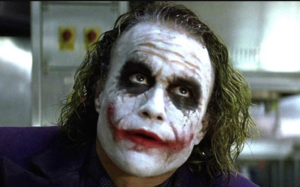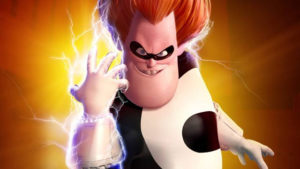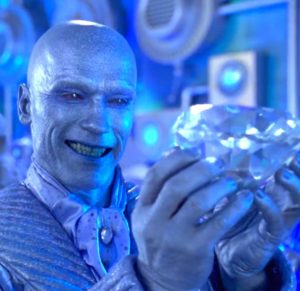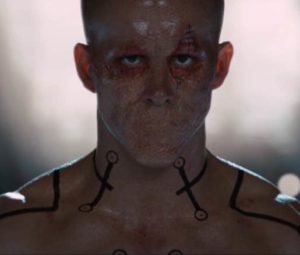When crafting a story, character design is going to be important, especially with two types of characters that will impart key flavors into your work and inflate your tale into pillowy goodness: Heroes and Villains. The key to a great hero is a great villain, which means the ability to write great villains is essential. An excellent way to craft an amazing villain is to examine the best and worst to see what makes them tick. Take a moment to put on your black hat, dust off your finest dastardly cape, and check your conscience at the door. Today we are walking with the bad guys!

This post contains some spoilers, so check the headings and read at your own risk!
The headings also have affiliate links to the films mentioned if you want to see the examples first-hand.
Great Villains
Not all Villains are created equal. If you want your story to shine you want your villain to be a cut above the rest. The problem is, what makes a bad guy good, so to speak? Let’s take a look at my top three villains and see what makes them so amazingly captivating.
Heath Ledger’s Joker (The Dark Knight, 2008)

For the perfect example on how to write great villains, we only need to look at The Dark Knight and Heath Ledger’s portrayal of the Joker. He knocked it out of the park and into the next town. Heath Ledger’s Joker in The Dark Knight propelled itself to its lofty position by Heath Ledger’s death after filming. The masterful crafting of the villain, and its execution, was the other key factor.
Heath Ledger’s Joker was incredibly unpredictable. He would go from being conversational and chummy (“You remind me of my father…”) to enraged serial killer (“I hated my father!”) in a flash leaving the audience permanently off balance. He also didn’t care about his own safety or survival. This freed him from what little restraint a normal bad guy would have. These two characteristics made him truly disturbing to watch.
This Joker was also incredibly clever and manipulative. Throughout the entire film, he had the entire city (along with its talented community of other villains) dancing by puppet strings to his every demented whim. He knew exactly where the weak points were and just how to exploit them for maximum chaos.
Buddy / Syndrome (The Incredibles, 2004)

The Incredibles is a kids film by Pixar about a family of superheroes forced to live in hiding due to legislation banning superheroes. The father had an obnoxious fan named Buddy back in his superhero days. He had no superpowers, but invented things that allowed him to emulate his hero. This ultimately makes him a liability and a nuisance.
Spurned by his child-hood hero, cute and obnoxious Buddy grows up to be the dangerous and ultra-rich villain Syndrome. Syndrome begins killing off superheroes to design a killer robot only he can defeat, thus installing himself as the ultimate superhero. Yes, this is a kids film and a very good one.
What makes Syndrome so compelling is that he could have been the hero of this story. He didn’t start out as bad guy, he dreamed of being a good guy and helping people. He wanted people to like him. All of us can relate to that, right? It was his frustration that nobody valued his mind when compared to super-powers that drove him to become evil. Again, we see parts of ourselves in him and that draws us in.
Syndrome also had complex motivation. He didn’t want to create a killer robot to destroy the world for giggles or to kill off all the superheroes. Instead, created the robot for marketing. His plan was to become famous by defeating an enemy nobody else could, then sell his gadgets so anyone could become a superhero. He explicitly states this in one scene: “When everyone is super, no-one will be.” The staff at Pixar certainly know how to write great villains.
Magneto (X-Men: First Class, 2011 & Days of Future Past, 2014)

The X-Men franchise has enough villains to choke the address book on an iPhone. Erik Lehnsherr, more commonly known as Magneto, stands out from the crowd like a sore thumb. He has the power to manipulate metal with his mind, but would stand out equally as much if his power was to conjure cuddly bunnies by doing jazz-hands.
What about Erik can we use to write great villains? The reason behind his horrifying actions is what makes him shine like a diamond. Erik lived during the period when the Nazi party rose to power and is a survivor of Auschwitz, the Nazi concentration camp. Later in life when he sees mutants being the subject of scrutiny and disdain, he sees the rise of the Nazi’s all over again and is determined to fight it. Not only does this make his reason for rising a mutant army to fight the rest of humanity plausible, but honorable. It’s his methods that cross the lines.
In the films X-Men: First Class (2011) and Days of Future Past (2014) we are given a look into the earlier years of Erik’s life. What we see is his deep and honest friendship with the main hero, Charles Xavier. The most poignant moments between them are when Charles tearfully pleads with him to not act from a place of anger and revenge, but Erik does anyway. The pain on Erik’s face in these scenes reveals that he doesn’t want to do these terrible things, but he can’t stop himself. He is broken and flawed, like we all are.
Terrible Villains
We can learn what to shoot for by looking at the best of the villains, but looking at what not to do from the ones that suck is just as valuable. I put on my gloves and scraped some real flops from the bottom of the villain barrel, just for you. You owe me.
Mr. Freeze (Batman & Robin, 1997)

With such an all-star cast, Batman & Robin should have been a good movie. It sported Arnold Swarsenegger, George Clooney, Chris O’Donnell, and Uma Thurman in it, so what went wrong? Many things, but one downfall of the movie was the terrible rendition of one of the main villains: Mr. Freeze.
Arnold’s character of the infamous freeze gun sporting married man was hamstrung by bad puns. Not just one, but every time he opened his mouth. It was a little fun at first, but it lost its charm fast. By the end of the film, I was rooting for the hero to beat him just so he would shut the heck up! When you strive to write great villains, think like a chef: A little salt can make a dish taste better, but the entire container will ruin a meal.
The bad puns were one thing, but the film also killed the true potential of the character. While the Batman universe had some cheesy bad guys, Mr. Freeze was not one of them. His wife was suffering from a rare disease, so Victor (Mr. Freeze) had her cryogenically frozen while he found a cure. All of his crimes were either to raise money for his research or acquire key components for the cure. He would attack heroes or villains alike if they stood in the way of his devotion to the woman he loved. Instead of that, we got warm beer night at the worst comedy club in town.
Deadpool (X-Men Origins: Wolverine, 2009)

I want to be clear, this is the gym-sock-full-of-crap Deadpool from X-Men Origins and not the Deadpool from the most recent two movies. Both were played by Ryan Reynolds, but the first on was… awful. He was practically an instruction manual on how not to write great villains.
What happened to make the character bomb so hard in Origins? The biggest nail in the coffin (of which there are many) was the absolute betrayal of the fan base. The fans were excited to finally see two of the most beloved characters in the X-Men universe finally grasp their time on the stage: Gambit and Deadpool. Both were bastardized versions of their original selves and received next to no actual screen time. The fans of the series expected one thing, the studio promised to deliver it and then… didn’t. An efficient way to make people mad at you.
To make things worse, as if that was needed, Deadpool’s arc was slapped together like an afterthought. He is introduced as a mouthy mercenary in the first part of the movie, removed from the plot, and then slapped back in at the end like a used band-aid on an overcooked steak. There was no actual development of the character and we didn’t get to see enough of him to give a crap about him by the end.
Laurel Hedare (Catwoman, 2004)

Who? That’s half of my point with this one. Laurel Hedare was the main villain in the 2004 film Catwoman starring Halle Berry. She was a beauty product mogul that was obsessed with her looks. If that sounds like a decent start to a villain then you would be right. It’s a shame it didn’t turn out that way.
Laurel’s terrible motivation was in part responsible for her lack of depth as a character. She developed a face cream that melted people’s faces and refused to pull it from the market because the company would lose money. Instead, she had the scientist and anyone else who knew about the side-effects killed, because that wouldn’t affect the company at all. At the end of the film, the hero (Catwoman) scratches her face and she commits suicide because now she is hideous. I like to think I’m an imaginative person, but I don’t think I could come up with a less relatable villain.
The second thing that Laurel Hedare’s character did was violate the cardinal rule of villainy: Be Memorable. If you want to write great villains, they must be memorable. All I remembered about Laurel Hedare was she was blonde and a fairly terrible villain. That’s it. A villain too weak to be remembered has no hope of providing enough resistance to make a good hero, or a good story.
Recap
This has been quite a journey and there is a truck load of information here, so let’s recap what we have learned.
Be Sure To:
- Make them unpredictable and disturbing
- Make them dangerously smart
- Let them be a little bit of a hero
- Give them a good (or complicated) reason for being bad
- Make them flawed and human
- Make them relatable
Be Sure Not To:
- Give them terrible dialogue
- Give them stupid or flat reasons for being bad
- Promise your readers something you don’t deliver
- oss them into the plot thoughtlessly
- Let them be forgettable!
Here is this week’s book report:
Words Written (Week 9): 884 of 2,200 (…rough week)
Words Left: 29493
Last Three Words Written: Strange said happily. (Strange is a character by the way)




Life has a way of getting in the way of your word count goal (thanks for the explanation in your newsletter). I appreciate all the research that went into this post. You did an excellent job of distilling it down to the main points to consider.
Thanks for letting me know what you thought about the post. I actually had to cut this one down considerably in editing because there was so much to say about these villains!
Pingback: What is an Antihero? (Heroes You Love to Hate) - Merchants of the Void